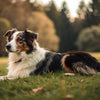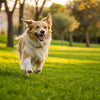How Long Should My Dog Pant After Exercise? Understanding Your Canine's Cooling Mechanism
- Houndsy
Table of Contents
- Introduction
- The Science Behind Panting
- How Long Should My Dog Pant After Exercise?
- Cooling Down: What to Do After Exercise
- The Importance of Hydration
- Recognizing When to Seek Veterinary Care
- Conclusion
- FAQ
Introduction
As dog owners, we often marvel at our furry friends’ boundless energy and enthusiasm for play. But have you ever wondered what happens to their bodies during and after exercise? Did you know that dogs can take anywhere from 10 to 30 breaths per minute while at rest? After vigorous activity, that number can skyrocket, leading many owners to ask, “How long should my dog pant after exercise?”
Understanding this can significantly enhance our pet care routines, ensuring our beloved companions remain healthy and happy. This blog post aims to explore the intricacies of dog panting, including the reasons behind it, how to recognize normal versus excessive panting, and what to do in case of emergencies. By the end, you will have a clearer understanding of your dog's post-exercise needs and how to keep them comfortable.
We will also highlight practical ways to enhance your dog’s feeding experience, aligning with our mission at Houndsy to simplify and elevate daily pet care. So, let’s dive in!
The Science Behind Panting
Why Do Dogs Pant?
Panting is a dog’s primary means of regulating body temperature. Unlike humans, dogs have very few sweat glands, primarily located in their paw pads. Thus, they rely on the process of panting to cool down after exertion or when feeling overheated. When dogs pant, they inhale cooler air and exhale warm air, which helps dissipate heat from their bodies.
The Mechanics of Panting
- Breath Rate: When resting, a dog's breathing rate can range from 10 to 30 breaths per minute, depending on size and breed. After exercise, this can increase significantly.
- Cooling Mechanism: Panting allows for the evaporation of moisture from the tongue and respiratory tract, further cooling the dog’s body.
- Normal vs. Excessive Panting: While panting is entirely normal after exercise, excessive panting that continues for an extended period or occurs at rest can indicate a problem.
Factors Influencing Panting Duration
Several factors can determine how long a dog should pant after exercise:
- Intensity and Duration of Exercise: A light walk may result in less panting than a vigorous game of fetch.
- Environmental Conditions: Hot and humid weather can lead to increased panting duration. Dogs can take longer to cool down in these conditions.
- Breed: Brachycephalic breeds, such as Bulldogs and Pugs, are more prone to overheating and may pant longer.
How Long Should My Dog Pant After Exercise?
General Guidelines
- Short Duration (Normal Panting): After moderate exercise, a dog should typically return to a normal breathing rate within 10 to 30 minutes. You should notice their breathing slow down as they cool off.
- Longer Duration (Excessive Panting): If your dog continues to pant heavily for more than 30 minutes after exercise or exhibits signs of distress, it’s crucial to monitor closely.
Signs of Distress
Understanding your dog's normal panting rhythm will help you identify when something might be wrong. Here are a few signs to look out for:
- Persistent Heavy Panting: If panting continues despite resting and cooling down.
- Disorientation or Weakness: If your dog seems dazed or has trouble standing.
- Color Changes: Gums appearing pale, blue, or purple can indicate poor oxygenation, requiring immediate veterinary care.
Cooling Down: What to Do After Exercise
Gradual Cool Down
Just as athletes cool down after a workout, dogs benefit from a gradual cool-down period. Here are some tips to help your dog transition back to a resting state:
- Slow the Pace: Near the end of your exercise session, decrease the pace to allow your dog’s heart rate and body temperature to decrease gradually.
- Hydration: Always have fresh water available. Let your dog drink small amounts frequently to avoid gulping too much and causing stomach upset.
- Rest: Provide a shaded or cool area for your dog to relax in after exercise.
Additional Cooling Strategies
- Wet Towels: Drape a cool, damp towel over your dog’s back to help bring down their body temperature.
- Cooling Mats: Consider investing in a cooling mat designed for pets, which can provide a comfortable resting place post-exercise.
The Importance of Hydration
Ensuring your dog is well-hydrated is essential, especially after exercise. Dehydration can exacerbate panting and lead to heat-related illnesses. Here are some hydration tips:
- Regular Water Breaks: During walks or play sessions, take breaks for your dog to drink water—especially on warmer days.
- Portable Water Bowls: Invest in a portable water bowl or a specialized dog water bottle to make hydration easier on the go.
- Monitor Intake: Keep an eye on how much water your dog consumes. If they seem reluctant to drink, it might be time to consult a veterinarian.
Recognizing When to Seek Veterinary Care
Red Flags for Dog Panting
Understanding when panting becomes a cause for concern is crucial for every dog owner. Here are the situations that warrant a call to your veterinarian:
- Prolonged Panting: If your dog pants excessively for more than 30 minutes after resting.
- Accompanying Symptoms: If your dog shows signs of excessive drooling, vomiting, or has difficulty breathing.
- Behavioral Changes: If your dog becomes lethargic, disoriented, or unusually anxious.
Emergency Situations
Certain conditions can lead to severe consequences. If your dog exhibits any of the following symptoms, seek emergency veterinary care immediately:
- Heatstroke: Symptoms include excessive panting, vomiting, diarrhea, and a body temperature exceeding 104°F.
- Breathing Difficulty: Labored breathing, pale or blue gums, or collapse are critical signs that require urgent attention.
Conclusion
Monitoring your dog's panting after exercise is an essential part of responsible pet ownership. Understanding the normal range of panting duration, recognizing signs of distress, and implementing proper cooling and hydration strategies will help ensure your dog remains healthy and happy.
As we strive to enhance daily pet care, we invite you to explore our innovative solutions, such as the Houndsy Kibble Dispenser. Designed with both functionality and aesthetics in mind, our dispenser elevates the feeding experience, making it more convenient and visually appealing for you and your furry friend.
FAQ
How long should my dog pant after exercise?
Typically, a dog should return to a normal breathing rate within 10 to 30 minutes after moderate exercise. If panting persists beyond this timeframe, it's essential to monitor your dog closely.
What should I do if my dog is still panting heavily after resting?
If your dog continues to pant heavily after resting for 30 minutes, check for additional symptoms such as disorientation, weakness, or changes in gum color. If you notice any concerning signs, consult your veterinarian.
Can I exercise my dog after they have eaten?
It's generally advised to allow at least an hour after eating before engaging in vigorous exercise. This helps to prevent digestive issues and bloating.
What are some signs of heatstroke in dogs?
Common signs of heatstroke include excessive panting, drooling, a rapid heartbeat, vomiting, and a body temperature above 104°F. If you suspect heatstroke, move your dog to a cooler area and seek veterinary help immediately.
How can I help my dog stay hydrated during exercise?
Always carry fresh water and a portable bowl during walks or outdoor activities. Allow your dog to take frequent water breaks, especially on warm days.
By keeping these guidelines in mind and ensuring your dog enjoys a safe and healthy exercise routine, we can create a positive and enriching experience for our beloved pets.












